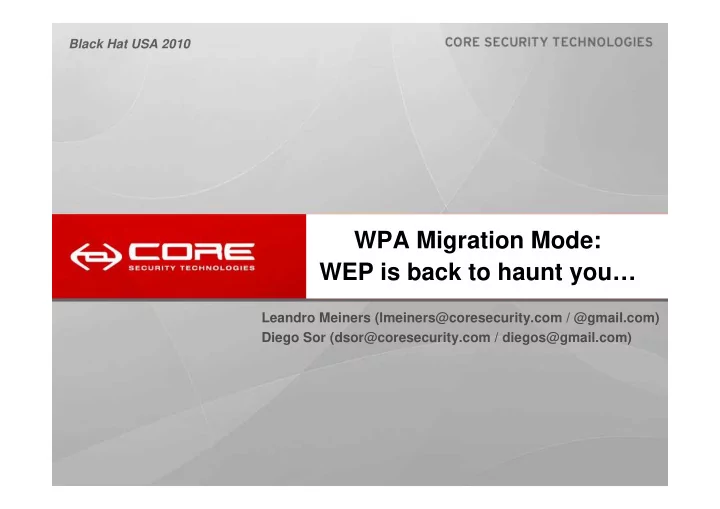

Black Hat USA 2010 WPA Migration Mode: WEP is back to haunt you… Leandro Meiners (lmeiners@coresecurity.com / @gmail.com) Diego Sor (dsor@coresecurity.com / diegos@gmail.com) ������ ��������������������������������������������� ����������������� ���������
Agenda � Introduction to WEP � Introduction to WPA Migration Mode � Attacking WPA Migration Mode � Mitigations and recommendations ������ ��������������������������������������������� ����������������� ���������
Introduction to WEP The boring… ������ ��������������������������������������������� ����������������� ���������
Introduction to WEP WEP Properties � WEP’s confidentiality: Based on RC4, which is a symmetric stream cipher: – � Symmetric: the encryption and decryption keys are the same � Stream cipher: encryption occurs one digit at a time � WEP’s integrity: Based on a ICV (Integrity Check Value) – � Implemented as a CRC-32 � WEP’s key management: IEEE 802.11 does not define any key management service – � WEP depends on an external key distribution/management mechanism � Generally, WEP keys are set manually ����� ��������������������������������������������� ����������������� ���������
Introduction to WEP WEP Encapsulation 1. Seed generation: The secret key is concatenated with an initialization vector (IV) (i.e. IV || Secret Key) 2. Compute ICV: CRC-32 of the plaintext (payload data) 3. Compute Key stream: Key stream = RC4(seed) 4. Encryption: Cipher text = Key stream XOR (Plaintext || ICV) 5. Message = IV || Cipher text �����! ��������������������������������������������� ����������������� ���������
Introduction to WEP WEP Message tampering � Checksum (i.e. CRC-32) is linear: CRC-32(A XOR B) = CRC-32(A) XOR CRC-32(B) – � Let C = [M XOR WEP(iv,key), CRC-32(M) XOR WEP(iv,key)], then it is possible for an attacker to obtain C’ where: C’ = [M’ XOR WEP(iv,key), CRC-32(M’) XOR WEP(iv,key)] – where M’ = M XOR � (only knowing C and � ) C’ = [M XOR WEP(iv,key) XOR � , CRC-32(M) XOR CRC-32( � ) XOR CRC-32(Zero) XOR WEP(iv,key)] Or… in layman’s terms: • xor the data with the mask ( ∆ ) • xor the checksum with the checksum of the mask ( CRC-32( ∆ ) ) �����" ��������������������������������������������� ����������������� ���������
Introduction to WPA Migration Mode Starting to get interesting… �����# ��������������������������������������������� ����������������� ���������
WPA Migration Mode What is WPA Migration Mode? Cisco’s WPA Migration Mode allows stations that support the following types of authentication and encryption schemes, to associate to the access point using the same SSID: � WPA clients capable of TKIP and authenticated key management. � IEEE802.1X compliant clients (such as legacy LEAP clients and clients using TLS) capable of authenticated key management but not TKIP. � WEP clients not capable of TKIP or authenticated key management. �����$ ��������������������������������������������� ����������������� ���������
WPA Migration Mode How WPA Migration Mode works � WPA Cipher Suite configuration: Multicast Cipher Suite: WEP – Unicast Cipher Suite: TKIP – � Using WEP as multicast cipher allows WEP and WPA stations to decrypt multicast traffic. � AP tracks encryption capabilities of each station, and because IEEE 802.11 networks are switched, the AP forwards unicast frames encrypted appropriately (WEP or TKIP). �����% ��������������������������������������������� ����������������� ���������
WPA Migration Mode Configuring WPA Migration Mode � WPA optional � A cipher suite containing TKIP and 40-bit or 128-bit WEP � A static WEP key in key slot 2 or 3 ap# configure terminal ap(config)# interface dot11radio 0 ap(config-if)# ssid migrate ap(config-if-ssid)# authentication open ap(config-if-ssid)# encryption mode ciphers tkip wep128 ap(config-if)# encryption key 2 size 128 AAAAAAAAAAAAAAAAAAAAAAAAAA transmit-key ap(config-if)# ssid migrate ap(config-if-ssid)# authentication key-management wpa optional ap(config-if-ssid)# wpa-psk ascii migrationmode ap(config-if-ssid)# end ap# ������& ��������������������������������������������� ����������������� ���������
WPA Migration Mode Detecting an AP with WPA Migration Mode Wireshark Filter: � Beacon frame: wlan.fc.type_subtype == 0x08 – � Has a WPA Information element: wlan_mgt.tag.number == 221 – � Multicast cipher suite is WEP (40 or 104 bit): wlan_mgt.tag.interpretation == "Multicast cipher suite: WEP (40-bit)" – wlan_mgt.tag.interpretation == "Multicast cipher suite: WEP (104-bit)“ – � Unicast cipher suite is TKIP: wlan_mgt.tag.interpretation == "Unicast cipher suite 1: TKIP" – ������� ��������������������������������������������� ����������������� ���������
WPA Migration Mode Detecting an AP with WPA Migration Mode (2) Wireshark Filter: wlan.fc.type_subtype == 0x08 and wlan_mgt.tag.number == 221 and (wlan_mgt.tag.interpretation == "Multicast cipher suite: WEP (40- bit)" or wlan_mgt.tag.interpretation == "Multicast cipher suite: WEP (104-bit)") and wlan_mgt.tag.interpretation == "Unicast cipher suite 1: TKIP " ������� ��������������������������������������������� ����������������� ���������
WPA Migration Mode Detecting an AP with WPA Migration Mode (3) Kismet (patched): ������� ��������������������������������������������� ����������������� ���������
Attacking WPA Migration Mode Now we are talking… ������ ��������������������������������������������� ����������������� ���������
Attacking WPA Migration Mode Scenarios “The effect of supporting both static or dynamic WEP clients and WPA clients is that security will operate at the least-secure level common to all devices . In WPA Migration Mode, although WPA key authentication, per- packet keying, and message integrity are enabled, this is not enforced for all clients. As a result, a passive WEP key attack could be launched against WEP users .” -- Cisco Systems WI-FI PROTECTED ACCESS, WPA2 AND IEEE 802.11I Q&A, 2004 � WEP stations still hanging around… � No WEP stations in sight… ������! ��������������������������������������������� ����������������� ���������
Attacking WPA Migration Mode WEP stations still hanging around… 1. Passively wait (and capture) for a broadcast ARP frame (distinguished by its characteristic size) that is answered by a WEP station. 2. Replay the captured frame. 3. Capture the ARP replies sent by the WEP station (under attack). 4. Run aircrack-ng against the captured frames to obtain the WEP key. Just fire aireplay-ng against a WEP station: aireplay-ng -2 -b <BSSID> -d FF:FF:FF:FF:FF:FF -f 1 -m 68 -n 86 <WIFI INTERFACE> http://aircrack-ng.org/doku.php?id=how_to_crack_wep_via_a_wireless_client ������" ��������������������������������������������� ����������������� ���������
Recommend
More recommend